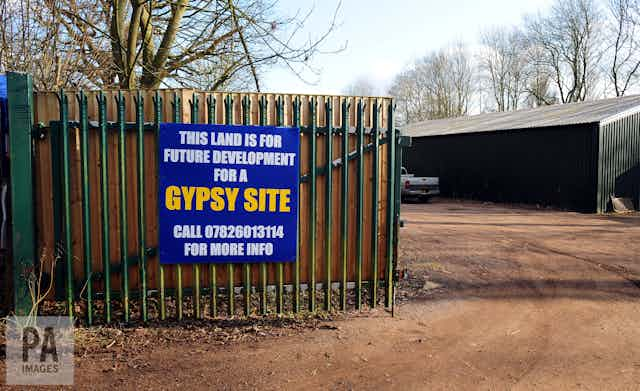Dee (not her real name) describes herself as “100% Gypsy. 1000% English Romany Gypsy. I’m one of those last acceptable Gypsies you can be racist to all day long!”
Dee echoed the title of a report by the Irish Traveller movement from September 2017: “The last acceptable form of racism”. The Traveller Movement is a charity that delivers support and advocacy for Irish Travellers and Gypsies – and the title of its report reflects how discrimination towards Gypsies is well understood and documented but still goes unchallenged.
When I interviewed Dee she had recently moved into a new Housing Association home and described her pleasure at its location in quiet suburban leafy streets. She had spent the past two years on a run-down estate and this was everything she hoped for. Except there were some niggling doubts. Dee felt the neighbours were a little distant with her: “They know we’re Gypsies and it always ends up badly.”
To prove it she unfolded a page from a local newspaper published in the 1970s. A two word headline – “Gypsies Evicted” – was accompanied by a photograph of cars and a caravan stopped in a lay-by and another of a young man talking to a policeman. The young man was Dee’s grandfather. The report of the eviction gave a somewhat rueful description of the police just “doing their job”.
Dee’s grandparents were evicted from land their family owned. A compulsory purchase order was used to acquire the land for development as a local authority managed Traveller site. Authorities are required to provide such sites to accommodate Gypsies living in mobile caravans or more commonly in static trailers. The shortfall of site provision has been widely acknowledged by successive governments.
The ironies of her family being made homeless in order to build a Traveller site were not lost on Dee, who situated them among a catalogue of problems her family faced over many decades. She had enduring memories of being evicted or moved on repeatedly as a small child until her own parents found more settled accommodation on another local authority site.
Let down by policy
The failure of planning law to meet the needs of Gypsy families is nothing new. The eviction of Dee’s grandparents was almost certainly a direct consequence of the 1968 Caravan Act; intended by parliament to force local authorities to address chronic shortages in site provision – but in practice implemented by local authorities as a means of evicting families from their homes.
More recently, 2015’s planning policy for traveller sites goes further, defining Gypsies and Travellers in terms of nomadic characteristics. Many Gypsies consider travelling a significant element of their identity and one reflected in their choice to live in caravans or trailers. But nomadic movement itself is rarely a reality of their daily lives.
I have argued that this policy results in fewer Traveller sites being developed because it fails to acknowledge the realities of many families who do not “travel” on a regular basis. This is a cause of great insecurity for many families and has a detrimental impact across a range of other outcomes, particularly in respect of children’s education.

If the main consequence of the 1968 Caravan Act was to make more families homeless and force them to live on the road, the current approach reframes such homelessness as a nomadic identity. At its heart is a “Catch-22” situation: families attempting to lead settled lives are effectively excluded from securing planning permission for new Traveller sites.
600 years of discrimination
We should not be surprised by the detrimental impact of policy on the lives of Gypsy families. There is a long, dishonourable history of this going back to the 15th century. Both Henry VIII and later Mary I passed a succession of Egyptians Acts that called on Gypsies to renounce their identity or face extradition, lose all property rights and eventually face the death penalty. Perhaps the most striking element of the Egyptians Acts is the language used to describe Gypsies in terms of dirtiness, itinerancy and criminality. Despite its archaic nature, it feels current – resonating with accounts we might read in tomorrow’s Daily Mail or Daily Express.
Since the Egyptians Acts, there has been a succession of policy that has marginalised the lives of families such as Dee’s. Ageless stereotypes about dirt and criminality seemingly drive a desire to keep Gypsy families separate and at arm’s length from other communities. The prevalence of local authority sites located adjacent to sewage treatment farms, waste disposal centres, cemeteries or on industrial and municipal land goes beyond the coincidental. It defines who belongs and who does not.
Ambiguous understandings of mobility and nomadism provide a useful shorthand for local authorities’ intent on not providing more sites. While travelling remains central to many Gypsies’ understanding of their own identities, it is rarely the reality of their lifestyles. There has been a consistent failure to address shortages of Gypsy sites by claiming these people are “not real Gypsies” – in other words, they do not conform to the imagined stereotypes of the settled population.
Bearing in mind the lack of general knowledge of central planks in Gypsy history: their migration from the Punjab more than 1,000 years ago, their settlement and sometimes enslavement in Europe since the Middle Ages, and the catastrophe of the Holocaust, this is perhaps unsurprising.
For Dee, the worries of being a mother with young children living on a limited income reflect problems faced by many families. But they are underscored by a sense she is an outsider from a community which has faced a long history of persecution. Her pleasure at finding a new home is tempered by wariness that her neighbours may regard her as an undesirable element in their lives.

